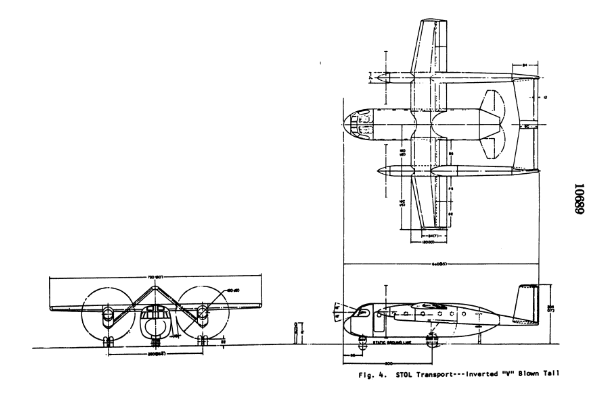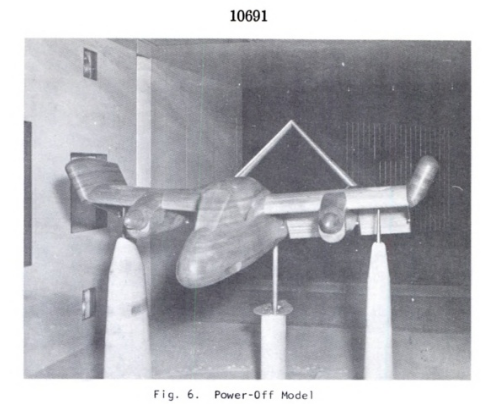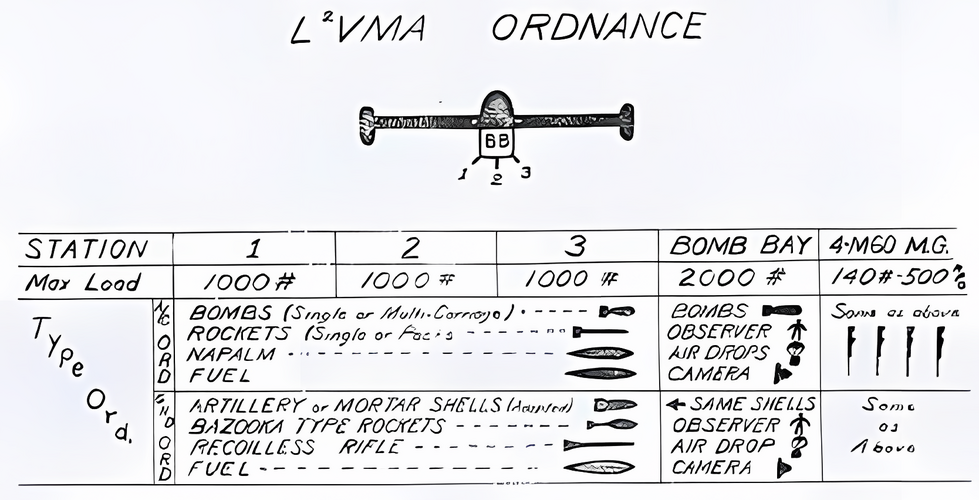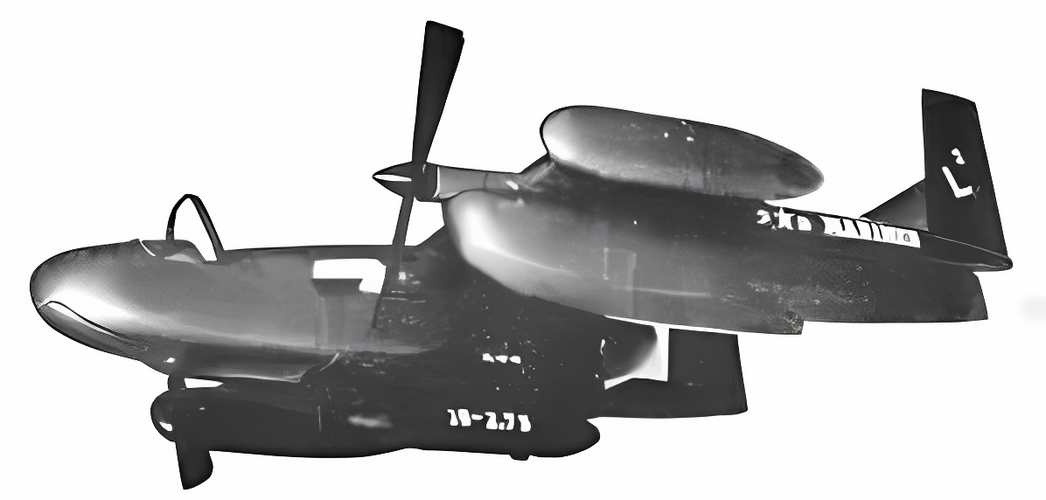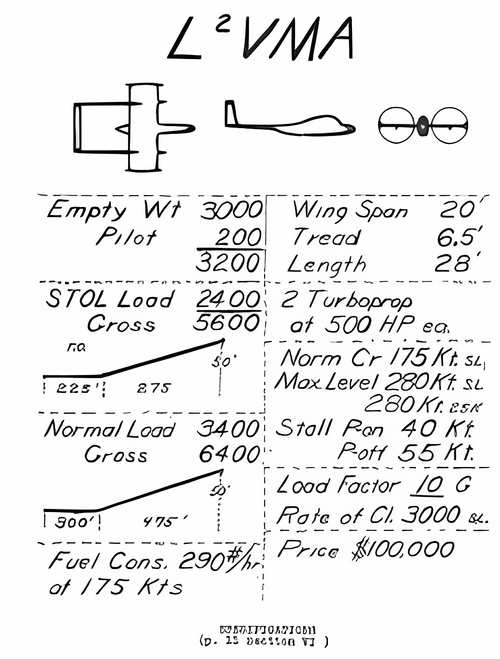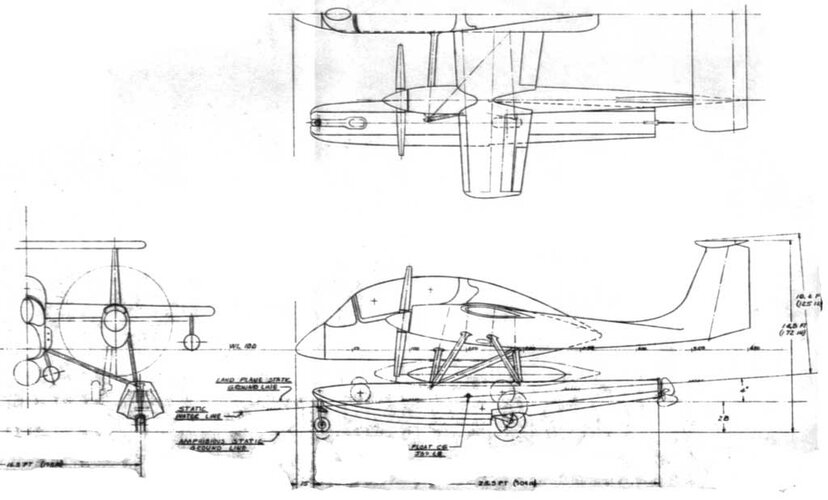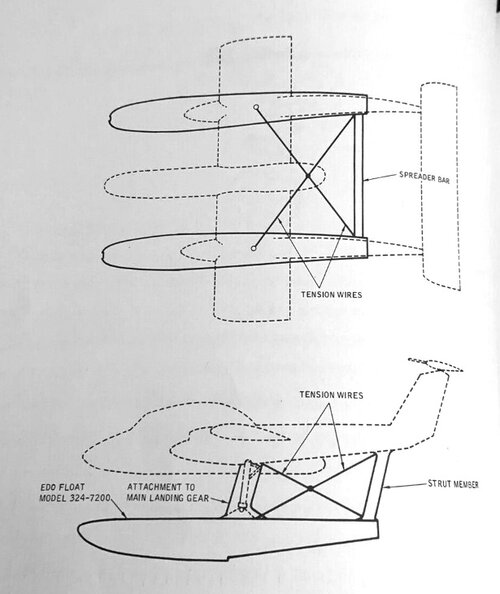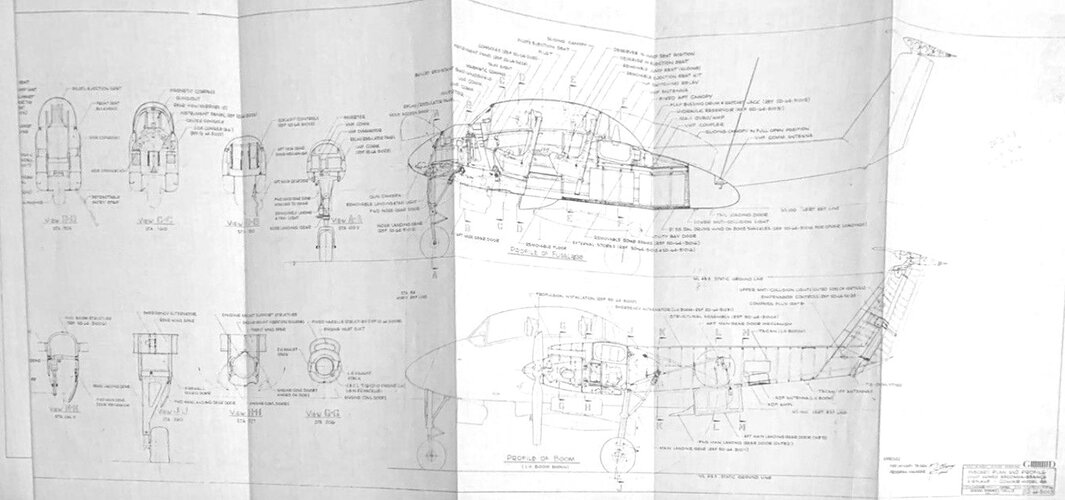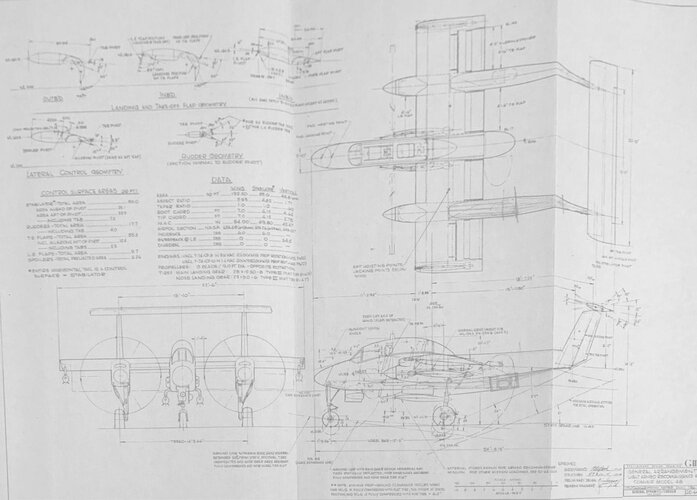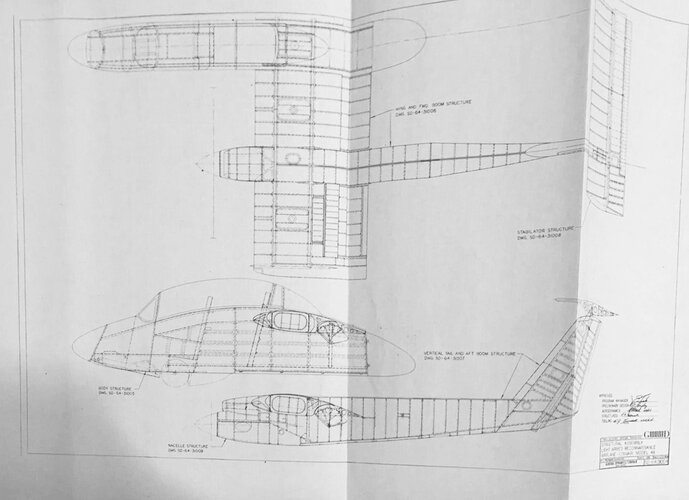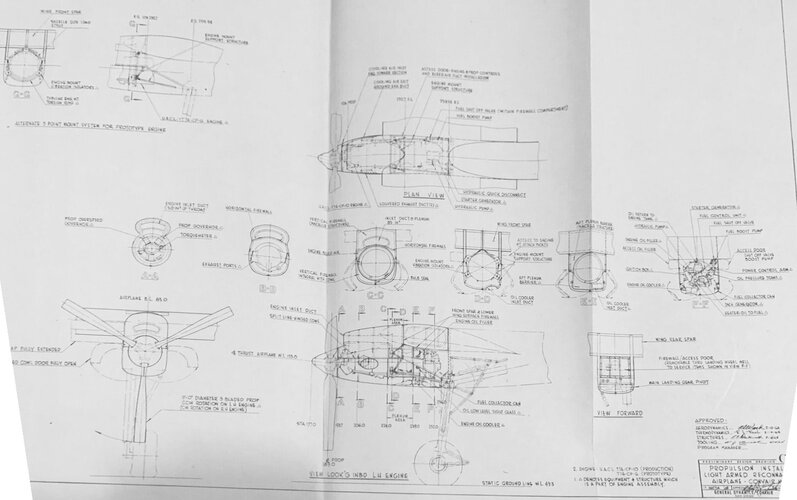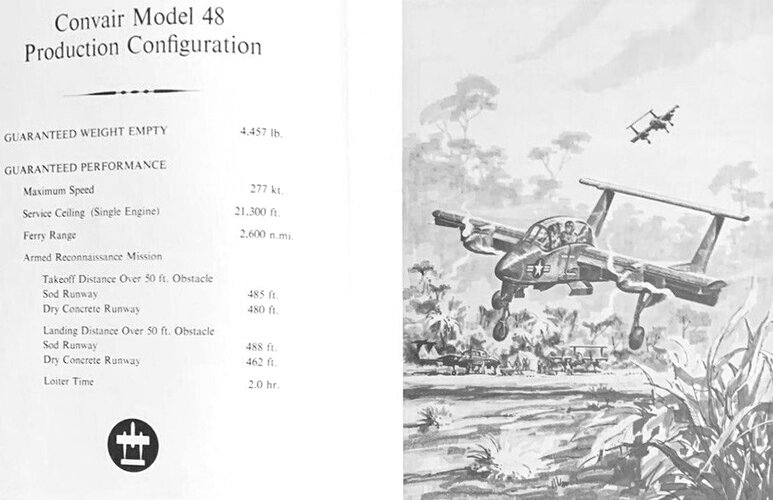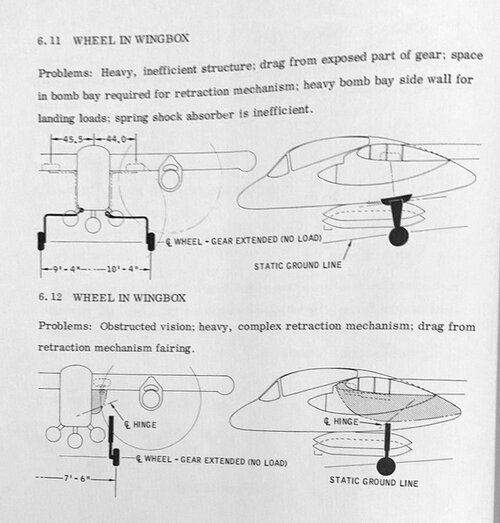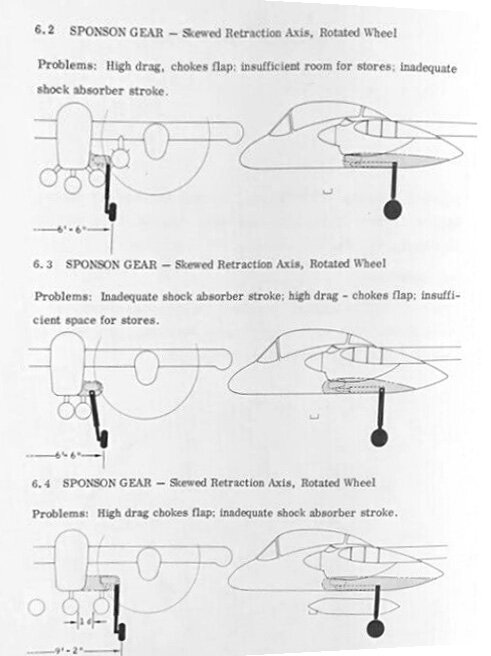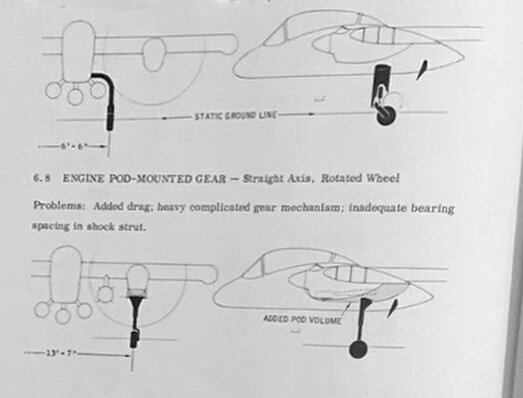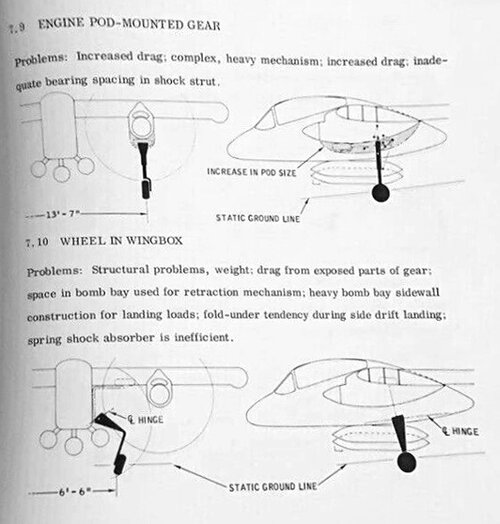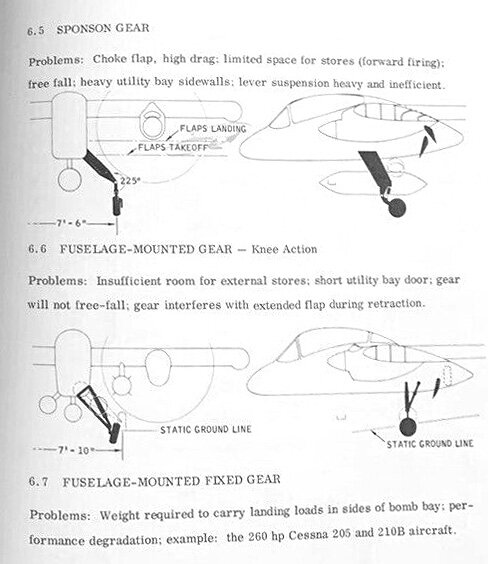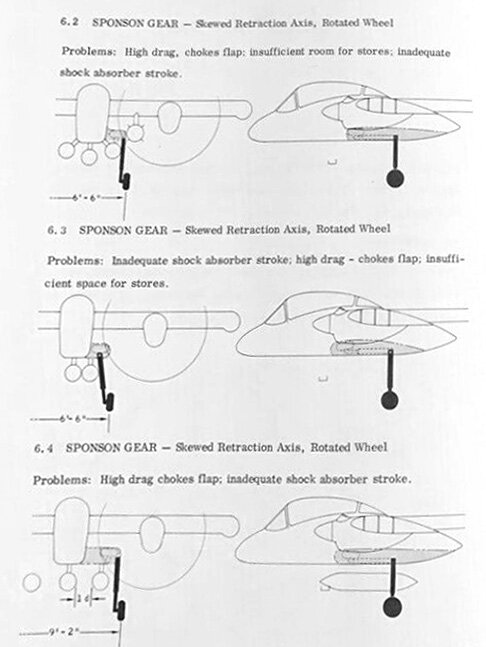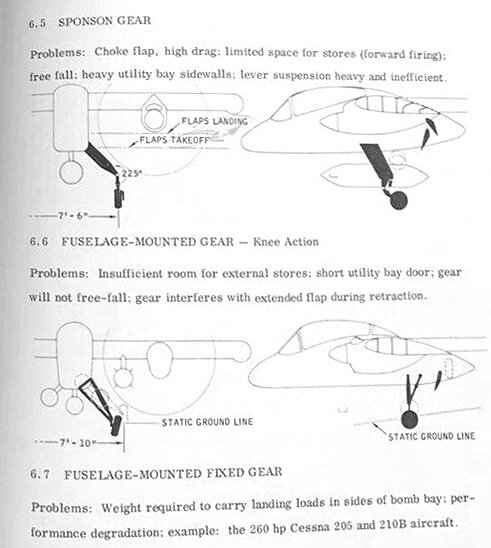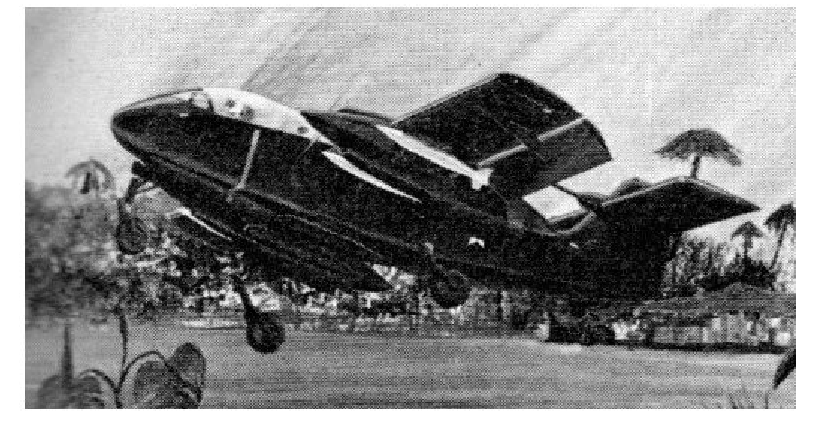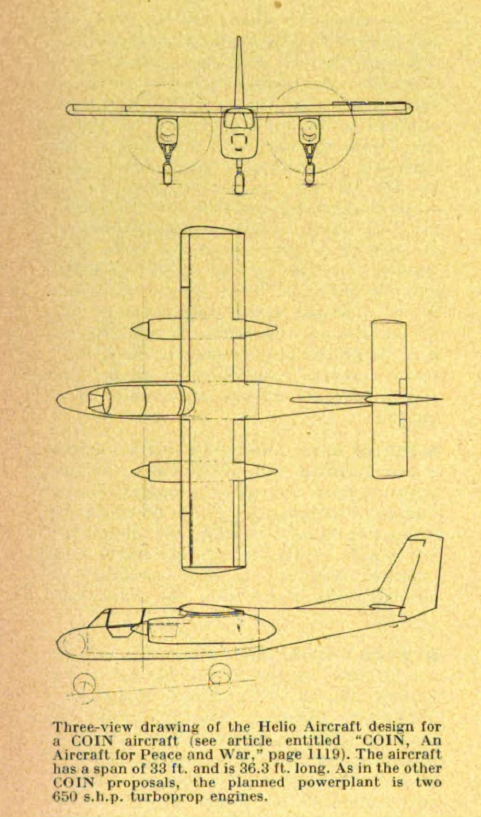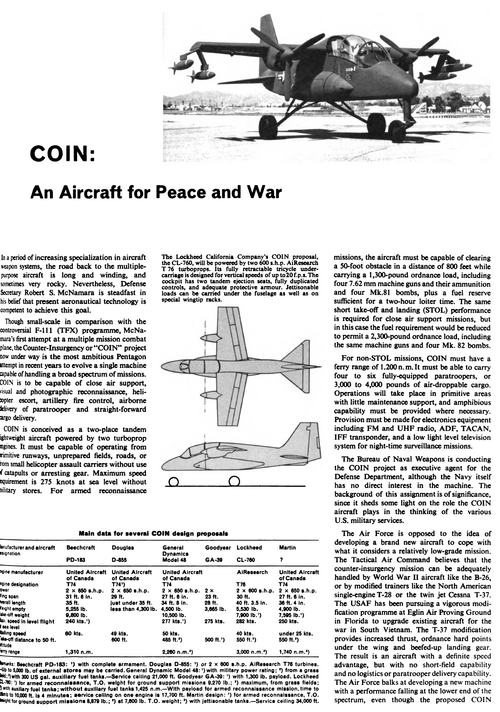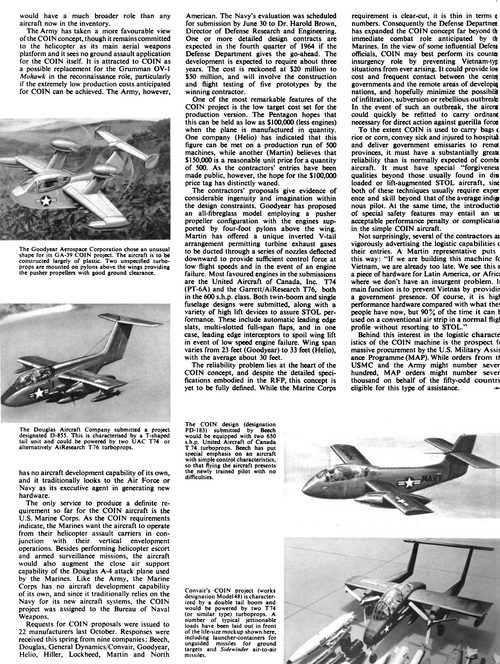Colonel KP Rice (USMC, retired) was involved in the development of the OV-10 Bronco, he has his own website and posted some of his experiences concerning that development.
http://www.volanteaircraft.com/ov-10.htm
I'm posting the full 1960 article by Majors Rice & Beckett here for posterity.
LIGHT LIGHT SUPPORT AIRCRAFT (L2 VMA)
THE NEED, CONCEPT OF OPERATION AND GENERAL SPECIFICATIONS FOR A VERY LIGHT S.T.O.L. SUPPORT AIRCRAFT
MAJ W.H. BECKETT, MAG-15
MAJ K.P. RICE, AIRFMFPAC
PREFACE
Sixteen years ago the aircraft industry hit the “con trails.” The atom was smashed, the sound barrier broken. The era of boom and zoom was launched in the middle of the mushroom clouds. The man in the Buck Rogers suit became the new hero of the new age. Thermonuclear annihilation “push button” style was as real a possibility as the miracle of the dial selector washing machine. But when the dark rain of fallout fell on an awestruck world, both sides of the international political question had grim second thoughts about resolving their differences by leaving a vacant spot in the solar system. The possibility of such a war remains with us. It must assuredly be prepared for!
Meanwhile, back in the foxholes of Korea, the jungles of Indo-China and the sands of Israel and Jordan, war proceeds pretty much as usual. Not the blast of the atom bomb, but the burst of machine gun fire breaks the silence of this “twilight peace” we are enjoying. The rifleman is no anachronism. He is very much with us and in active service. Read the daily newspaper.
The aviation complex, industrial and military, in its rightful pride and zeal, in being the instrument of the future and the vanguard for conquering space, has neglected the exigencies of current warfare and providing the requisite airborne support for same.
INTRODUCTION
Limited war is a current reality. The USMC is an ideal weapon in such a war. The following study is a consideration of the modern concept of limited war in terms of current aviation capabilities and weaknesses, both tactical and logistical, with special attention to the need for a new type of aircraft designed specifically to eliminate these weaknesses. Better air support than that which can be obtained with current high performance type aircraft is needed, especially for limited war situations. After studying the problem and determining in general the additional capabilities that are needed for adequate air support, various means of achieving these capabilities were examined. The most promising approach appeared to be a concept in which very light S.T.O.L. (short take off and landing) aircraft are used to supplement existing high performance types. Performance characteristics can be obtained with light aircraft which permit greatly increased effectiveness through tactical innovations. Further advantages can be obtained by developing applicable weapons and tactics simultaneously with the vehicle needed to implement them. Aircraft design and tactics are interdependent and both must conform to expected requirements and environmental considerations. The explanation of a light support concept and description of the aircraft characteristics necessary to implement it are therefore complicated by a certain amount of background material. The nature of war in which the Marine Corps might become involved in the next few years will be considered first. This will provide the background necessary to define current inadequacies in terms of probable combat environment. The advantages of meeting the resulting requirements through the use of a light attack vehicle will be compared with the possibility of replacing current aircraft with more complex and versatile types. Finally, specifications for a feasible light STOL support vehicle will be developed. Using the predicted performance of a sample vehicle, tactics for its employment will be described so that its effectiveness and viability can be evaluated.
ENVIRONMENTAL CONSIDERATIONS
1. General.
The maintenance of a strong deterrent is a prerequisite to national existence and cannot be neglected. On the other hand, the ability to react rapidly and effectively in a limited or cold war situation is the greatest immediate military problem facing the United States today. It has become obvious that limited or cold war operations are much more likely than an all out war. The Marine Corps, as a “force in readiness,” and by the virtue of its composition and amphibious capability, is particularly concerned with the limited war problem. While it is impossible to predict how and under what conditions a limited war would be fought, certain aspects of environment which could become critical in future operations can be foreseen.
2. Political Sanctuaries.
One of the most significant limited war factors from an aviation standpoint is that political sanctuaries are not only a possibility, but a probability. Without political sanctuaries somewhere, the war could not be limited. In a limited war between two major powers, sanctuary areas are almost certain to exist because any threat to an opponent’s strategic striking force will invite a thermonuclear holocaust. Attack on less vital sanctuaries will almost certainly enlarge the area of conflict. In the Korean War the Chinese Communists operated from a sanctuary behind the Yalu River and United Nations forces at sea or in Japan were not attacked. Many people were angered and dismayed at this development during the Korean War. In the future we must be ready with equipment and tactics to operate in this environment more effectively than the enemy.
3. Air Superiority.
The concept that air superiority is the prerequisite to victory and that it is achieved by bombing enemy airfields is inconsistent with a policy of limited war. Counter-air operations or the bombing of enemy airfields can no longer be accomplished except in the immediate combat area. The range of modern aircraft is such that few, if any, probable areas of operation are not within the range of likely sanctuaries. Since there is no way to eliminate the threat of attack from sanctuaries, we will have to be prepared to conduct military operations in spite of the threat of enemy air attack.
4. Air Defense.
Another factor that must be considered is the difficulty of providing an adequate air defense for large fixed installations like airfields and logistics centers. If ballistic missiles with nuclear warheads are used, however, defense is an almost hopeless problem, if the enemy is really serious about the destruction of certain targets. Almost all anti-aircraft weapons, fighters, missiles and artillery depend on radar for warning, target acquisition or guidance. Radar is the bottleneck in air defense. It can not only be attacked directly with air or missiles, it can be evaded or its capabilities saturated. In the most likely limited war areas such as the Middle East or Indo-China, overland approaches at low altitudes offer an obvious way of avoiding most air defenses. Since large, fixed targets would at least be subject to attack and possibly might not be able to exist in a combat area, passive, rather than active, defense measures will become more important. Even the use of VTO aircraft or SATS with arresting gear and catapult would not provide effective passive defense for high performance aircraft, however. The base facilities necessary for supply, fuel, maintenance, instrument approaches, etc. would make a remunerative target, even if the runway could be eliminated altogether. As a result, both friendly and enemy aircraft may be forced to operate from sanctuaries outside the area of operation. With any large, fixed installation subject to attack, ground forces will require more air support to replace heavy weapons that are limited by logistics. The limited amount of naval gunfire support available and helicopter transportability will also be factors.
5. Major Environmental Considerations.
A situation in which both sides are forced to operate aircraft from sanctuaries and all large targets in the objective area are destroyed is an extreme example and may never materialize. The following implications of this situation may apply wholly or only partially. However, they could be critical and must be treated as major environmental considerations:
a. Ground and air operations may have to be conducted in the face of enemy aerial opposition.
b. High performance aircraft may be forced to operate from sanctuaries outside the area of operations.
c. Large, fixed targets may be too vulnerable to exist in a combat area, forcing ground forces to use dispersion and limiting logistics.
d. More direct air support will be required by ground forces than has been required in the past.
CURRENT INADEQUACIES - AIRSUPPORT REQUIREMENTS
1. General.
With these conclusions in mind, let’s examine the requirements for air support more closely. First, while preparing for a limited war, we must still be ready for an “all out” nuclear conflict. The same aircraft that provide an adequate nuclear delivery capability for an “all out” war can also provide an adequate capability against large, fixed targets in a limited war. This capability is good whether nuclear or conventional weapons are carried. The development of the SATS concept provides the ability to deploy powerful aviation units to almost any area of the world. Even if operations may not be possible from fields in the actual combat area, the range of modern tactical aircraft permits their use over that area. When support requirements of ground forces are examined, however, we find important inadequacies.
2. Target Acquisition.
Current high performance aircraft are limited first of all by their target acquisition capability. It is impossible to spot many small fleeting targets from a high speed jet. Mosquito aircraft were necessary to spot targets even for prop type aircraft in Korea. A fleeting target spotted by the pilot of a jet, in many instances is lost before he can get into position for a run.
3. Armed Reconnaissance.
A definite armed reconnaissance capability is needed. Not only must fleeting targets be dealt with, but intelligence is required. There is no means at present to fill the gap between reconnaissance that can be provided by helicopters and that provide by high performance aircraft and drones. Neither is adequate for providing timely information on enemy armor, mechanized or helicopter borne movements. Not only must the ground commander be warned of enemy movements of this nature, but an immediate attack should also be made.
4. Helicopter and Mechanized Forces.
Dealing with helicopters and mechanized forces is a special problem. None of the current high performance aircraft have a reasonable capability against either. Even with missiles like Bullpup and Sidewinder available, it is difficult to see how properly equipped aircraft can be provided in time to find the targets or effectively employ the missiles, if they do. Dispersion and the use of cover and concealment will make the targets hard to find and the limitations of missiles at low altitude and close range will make the targets hard to hit. Support of helicopter and mechanized operations is similarly limited due to the fundamental disparity in normal performance and operating environment.
5. Discrimination.
Discrimination, or the ability to apply the proper amount of force on a few large targets or many small targets is especially required in limited or guerilla warfare where political and economic considerations are important. Inaccurate or excessive force can so damage a cause politically that the military gains are cancelled. The safety of troops being supported also comes under this heading. High performance aircraft can carry larger loads, but do not have the accuracy or flexibility required for adequate discrimination where small targets are concerned. The recent addition of multiple racks on the A4D is a progressive step, but the fact that area bombing techniques are being developed for their use is an indication of the pinpoint accuracy that can be expected. An A4D with multiple 250lb bombs is not the ideal weapon to use against a guerilla on a camel. Likewise its use in close proximity to our own troops is not calculated to raise morale. The strafing capability that provided a high degree of discrimination in the past, has been greatly weakened by the type of guns and ammunition carried by most high performance aircraft as well as by their performance characteristics.
6. Integration with Ground Forces Scheme of Maneuver.
For effective limited war operations the air support effort should be as closely integrated with the ground scheme of maneuver as is the artillery which it will have to replace to an ever greater degree. This can be achieved only by utilizing aircraft that are readily available, properly armed and whose pilots are at least familiar with the ground situation. The difficulties here are obvious. The number of aircraft available, their discrimination and target acquisition capabilities, control and communications all present serious problems. Even navigation to the target area might become a serious problem in some instances, if NAVAIDS like TACAN are not located nearby. Enemy aircraft and missile tactics as well as economic and logistic factors oppose the use of support planes circling on station waiting for targets.
7. Requirements.
The probable environment of future wars is such that mobility, flexibility, passive defense and logistics will be of paramount importance. Ground forces will require more air support that they have in the past. In order to provide the requisite support future operations will require:
a. A much better target acquisition capability.
b. A good armed reconnaissance capability.
c. A discriminating close support capability.
d. A better mechanized and helicopter attack support capability.
e. A method of integrating air support with ground scheme maneuver.
MORE COMPLEX AIRCRAFT
1. General suitable and Effectiveness.
It is the inability to deal adequately with small, fleeting targets that accounts for most of the inadequacies in air support. The development of highly sophisticated electronic equipment for new attack aircraft like the A2F is one approach to the problem. When equipment like side looking and terrain clearance radar is perfected and used in conjunction with some of the newer guided weapons, it will provide a really formidable all-weather capability. Developments along this line are desirable because of the great improvement in total effectiveness they will permit especially in bad weather and at night. The price will be high, however, in maintenance and logistic support as well as in initial cost. Moreover, it doesn’t solve the basic problem. Relatively large numbers of aircraft are required to find and destroy numerous small targets. Even if the effectiveness of these new developments is granted, it seems fairly obvious there would seldom be enough of these specialized aircraft to meet all requirements. Integration with the ground scheme of maneuver would be especially difficult, if the supported units were small and separated and the aircraft were based in a sanctuary some distance away. Discrimination and survivability are also problems. In short, the use of new type aircraft with sophisticated electronic equipment will provide a valuable capability, but will not meet all requirements for dealing with multiple small fleeting targets.
THE LIGHT STOL SUPPORT CONCEPT
1. General.
The development of new aircraft and associated weapons systems has been characterized by a mechanical approach to combat. Speed is the answer to defense and survivability problems; range is the answer to the vulnerability of the base; black boxes are being added for target acquisition. While this approach has produced many advances, it has limitations. The previously noted inadequacies can be attributed largely to an emphasis on performance as a substitute for tactics. Analysis of the close air support problem indicates that here, at least, is one issue that can be better solved by making the weapon implement the tactics, than forcing the tactics to support the weapon.
2. Concept of Operations.
The light STOL support concept involves a new type of tactical aircraft distinct from the fighter, attack and observation types presently in use. It is intended to supplement high performance types presently in use by exploiting military possibilities in the lower end of the performance spectrum. Light support aircraft would operate at low altitudes with relatively light loads. Effectiveness would be achieved by getting close to the target for extreme accuracy. The ability to conduct dispersed operations from roads or unprepared terrain in the vicinity of supported elements would minimize problems of security and defense against air attack. Evasive tactics, heavy armor and low radiation return, rather than speed would be used for defense in the air. Logistics requirements would be kept to a minimum by simplicity of design and by the use of infantry type ordnance and supporting equipment as far as possible.
3. Capabilities.
This type aircraft could provide the ground commander with limited, but effective, air support. The commander would be able to counter or support armored or helicopter operations. He would also have an effective means of observation and target acquisition. In addition he would have an accurate discriminatory weapon to use against the many important targets that are too small to justify the use of more expensive weapons. The armed reconnaissance capability would be especially valuable in limited or guerilla type operations.
4. Feasibility.
The key to this concept obviously is the airplane and its capabilities. Can an aircraft be built within the current state of the art which has the requisite performance? If it can be built, how will it be operated? Who will operate it and what tactics will be necessary to provide for accomplishment of its mission with reasonable survivability? To answer the first question it was necessary to design an actual airplane making the many compromises that are a part of every design. The performance of the resulting aircraft can be used to evaluate its theoretical combat effectiveness.
Specifications and design requirements
1. Operate with Supported Troops.
The first design requirement considered was that the airplane be able to operate with the supported troops without the necessity of any fixed base installation. This would permit integration with the ground scheme of maneuver and provide the minimum passive defense against counter air operations in the combat area. Operations from within a regimental or battalion perimeter would also minimize the security problems that beset forward tactical airfields, especially where guerilla action on infiltration tactics are considered. The military definition of STOL (500’ to a 50’ obstacle) allows takeoff and landing in moist of the areas in which limited war might be fought. In addition, the airplane was designed to use roads so that operation would even be possible in jungle areas where clearings are few and far between. As a result the wingspan was limited to twenty feet and a heavy trailing arm type landing gear with a tread of 6.5ft was provided for operation from roads. Float operation is feasible.
2. Minimum Logistics.
Operations with the supported troops also demand that logistics be kept to a minimum. Therefore, the airplane is small having a gross weight of 5300lbs for STOL operation. Two turboprop engines of 500hp each using 7 ½’ props and the principle of deflected slipstream can provide the necessary takeoff performance. Fuel consumption would not be excessive – about 50 gal/hr and the engines can be burned, i.e., MO-gas, kerosene, JP-5. Simple design and more particularly the elimination of “black boxes” should make maintenance easy. Very little support equipment should be needed since there is no component that cannot be lifted by hand. Provision for the use of infantry ordnance further simplifies the logistics problems. A small bomb bay and external racks can be used for carrying bazookas, recoilless rifles or 4.2 mortar shells, if they can be modified efficiently for aircraft use. The primary weapon would be multiple M-73 machine guns. This allows maximum flexibility. If logistics are critical and STOL operations necessary, infantry type ordnance would be carried and all necessary support provided by 6x6 truck or helicopter. On the other hand, if an air base or carrier were available, better than 2,000lbs of aviation type ordnance could be carried.
3. Ordnance.
a.
General.
It is not considered necessary or desirable to carry an extremely heavy ordnance load. Accuracy, proper tactics and weapons matched to targets will provide effective firepower as distinguished from blind, destructive force. Provision is made for a capability against relatively soft, fleeting targets like troops and unarmored vehicles; for hard point targets like tanks; and for larger targets like bridges and bunkers. The aircraft will be able to carry sufficient ordnance to execute an interdiction type strike effectively and still provide a good armed reconnaissance capability on the same sortie.
b. Guns.
The most effective all around weapon will be the four 7.6mm machine guns (or similar type weapons) which are effective against
troops, unarmored vehicles and helicopters. Strafing is not limited by safe separation requirements and targets can be hit with precision without risking damage to nearby personnel or property. There would be no particular problem in mounting 20 mm guns, if necessary. However, unless developments like the German anti-tank 20 mm prove effective, the heavier guns would probably not be desirable.
c. Hard Point Targets.
The problem with hard, point targets like tanks is to get close enough for a direct hit without getting caught by blast effect. The easiest weapon to use would be the 106 recoilless rifle because of its accuracy, effectiveness and minimum blast problem. However, these weapons are quite heavy, provide only one shot and haven’t as yet been used from aircraft. Aircraft rockets like Zuni or the 2.75 while not as accurate are considerably lighter. The bazookas or the newer LAW could be fired at a close enough range to score hits and still avoid excessive blast effects. Another possibility is dive bombing with small bombs. The Germans had some success with this approach in World War II on the Russian Front. Guided missiles like Bullpup or some of the smaller types could be carried, if necessary.
d. Miscellaneous Targets.
For bunkers, roads and rail cuts and bridges, low level attack with delay fuse bombs seems to be the best approach. Napalm, a number of small bombs or possibly mortar shells or their equivalent could also be carried, if the situation so warranted.
While further evaluation of specific weapons is required, the aircraft will be able to carry a sufficient quantity of aviation or modified infantry type ordnance to provide an extremely flexible capability. The following loads would be feasible and give an indication of the possibilities of the aircraft:
(1) In a dispersed situation, operating with the infantry, where logistics are critical and aviation type ordnance is not available.
(a) Four machine guns for troops, unarmored vehicles and helicopters.
(b) Packages of Bazookas or LAW rackets for use against tanks and hard, point targets. If these aren’t practical, two-106 Recoilless Rifles could possibly be carried.
(c) Up to twelve-4.2 mortar shells or the equivalent in the bomb bay for area type targets. The bomb bay could be used alternately to carry up to 500lbs of supplies for air drop.
(2) From a short forward airfield with aviation ordnance:
(a) Four machine guns for troops, vehicles and helicopters.
(b) A choice of five inch or 2.75 rocket packs or guided missiles for tanks and hard, point targets.
(c) A 500lb GP or napalm bomb.
(d) An observer and a camera in the bomb bay.
4. Protection Against Small Arms
is provided by approximately 400lbs of armor around the cockpit. Since there are two engines which are very small targets, they will either be lightly armored or not armored at all. The fuel will be carried in tip tanks that can be jettisoned, if set on fire. A small 10-15 gallon sump tank will provide protected fuel for return and landing.
5. Maneuverability
is required for the violent jinking which experience has shown to be very effective evasive action. The 30-35lb wing loading, 10-G load factor, low stall speed and a 3,000’ per minute rate of climb should permit impressive maneuverability. The top speed is approximately 260kt indicated. It is estimated that an average combat speed in the vicinity of 175kt ca be maintained even with continuous violent maneuvering.
6. Low Radiation Return
will provide a desirable defensive characteristic, if more sophisticated weapons systems are encountered. Low radar return will be achieved by maximum use of fiber glass structures and anti-radar “paint.” Infrared output will be small to begin with and the addition of exhaust shielding should effectively neutralize the threat of IR missiles like Sidewinder and Redeye.
7. Armed Reconnaissance.
Since an armed reconnaissance capability is required and it is visualized that many of the tasks performed by fixed wing VMO types could also be performed, provision is made for two seats. The seat for the observer is located in the bomb bay and can be removed when not in use. Visibility is o prime importance in an aircraft of this type. Therefore, a configuration with both seats in front of the wing was decided upon. The wing is set approximately even with the pilot’s shoulders providing 360 degree visibility above the wing. Un obstructed visibility forward and back under the wing for a considerable distance gives the pilot the best possible combination. The observer is limited by the pilot in front of him and the wing behind him, but he should be able to see almost straight ahead by looking around the pilot’s head and will be able to back under the wing about 30 degrees. Side by side seating was rejected because it would limit visibility for the pilot in the attack role. Increased frontal area would also cause more drag and present a better target.
8. Safety.
Because of its small size and moderate speed this airplane can be made quite strong. It is designed to withstand a load factor of 10-G so that the pilot needn’t worry about exceeding the limits. The combination of low stall speed and robust construction should make it relatively safe in the event of a crash landing or ditching. However, the reliability of the two engines makes forced landings an unlikely eventuality. Ejection seats are not considered necessary since bail-out over the side could be accomplished. On an aborted takeoff, a forced landing would probably be safer than ejection because of the low speed. This airplane should be safe and easy to fly, thus enabling the pilot to concentrate on tactical training rather than long check-outs and involved instrument procedures. While instrument flying will be provided, it is considered that this type of aircraft should be flown VFR exclusively in combat. Operations are possible with a ceiling of 200 feet with one-half mile visibility and dive bombing can be conducted with a 2,000ft ceiling. While operations will not be possible 100% of the time, they will be possible a higher percentage of the time than in current attack types and, moreover, without the necessity of any landing aids like CGA.
9. Transport to the Area of Operations.
For transport to the area of operations there are a series of choices. With ferry fuel tanks a range of over 2,000 miles can be obtained at a cruising speed of about 240kt at approximately 25,000ft. If a carrier deck were available, of course, the airplane could fly off with ease and it should be noted that storage space required would be small. While the first experimental aircraft will not have this feature, it is quite feasible to design the various components so that it can be disassembled easily and stored in a box that would fit in a 6x6 truck bed together with the equipment needed for re-assembly in the field. It could thus be transported by amphibious shipping and either heli-lifted or driven ashore by a 6x6 truck.
10. Deep Rescue.
The airplane has what appears to be a very good capability for deep rescue in enemy territory. The STOL characteristics would permit landing near a downed pilot who could enter the plane rapidly through the bomb bay doors. The armor, low radiation return and relative high cruising speed compared to a helicopter would make it valuable at long ranges in spite of the fact that the helicopter’s ability to hover would over-balance these factors at short ranges.
11. Communications
is always a problem in combat. In this case it appears that the provision of a standard UHF a/c radio would permit control through ANGLICO facilities and communication with high performance aircraft. The UHF facilities could be used for overriding central control by a TACC for rescue or emergency. It would also be used to control high performance a/c on targets where their heavier ordnance was necessary, adding an airborne controller to the ANGLICO capability. L.F. radio of some sort is also required in order that intelligence and gunfire spotting missions can be accomplished. This should not pose a difficult problem. In most cases organic infantry communications equipment could be used and, in addition, there is space in the back bomb bay for it.
TACTICS AND EMPLOYMENT
1. Organization.
Now that the airplane has been described, general principals affecting tactics and employment will be covered in order that its effectiveness and survivability can be evaluated. An organization will have to be developed which is flexible enough to provide administration, maintenance and training in garrison and to permit either centralized or local control in combat. If the tactical situation permitted, a small airstrip with central logistics support would allow maximum efficiency and flexibility in accordance with the concept of centralized control. In a dispersed situation, where logistics, communications and passive defense were controlling factors, a small headquarters based at the nearest available sanctuary field could provide major maintenance and replacements for units operating with a regiment or battalion. For operations in the field, aircraft would probably be used in pairs. This would permit a choice of single plane operation with a back-up or section operation. It would also allow more efficient use of the limited support equipment required.
2. Tactics.
Tactics would, of course, depend on the enemy situation and whether centralized or local control were used. The performance characteristics of this light attack type are such that everything from single plane missions using low altitude evasive tactics, to coordinated strikes utilizing the principles of flak suppression, saturation and diversion could be used. Speed is the only “tactic” that is not available. On the other hand, the tight turning radius and low combat speed of the light attack plane will permit dive bombing as steep as 70 degrees with a release altitude below 1,000ft. In addition, strafing and low level runs can be pressed to a very close range. An extremely high degree of accuracy can be achieved in this manner since accuracy is a function of range. Maneuverability and moderate speed in combat will also be extremely valuable in rough terrain and against hard targets such as tunnels or bunkers.
(a) Helicopter Operations will require considerable attention in the future and the light attack type is ideally suited to this problem. Performance characteristics are such that helicopter operations can either be supported or opposed with facility. The light attack is fast enough to catch helicopters or provide cover for them, but is not too fast to operate in the same general area. It also has the firepower and maneuverability necessary for rapid decisive action and attack.
(b) Defense Against Fighters and Guided Missiles will be accomplished primarily by evading the radar that these weapons depend upon so heavily. Infrared shielding will provide additional protection. In the event that enemy fighters do make contact the addition of a pair of Sidewinders would leave the enemy with little advantage except initiative.
SUMMARY
1. General.
The tactics and aircraft design which resulted from this study embody many innovations and further development and testing will be required to perfect detailed aircraft specifications and tactical doctrine. The use of light aircraft does show considerable promise, however, and the major aspects of the concept can be evaluated by an application of the checks of suitability, feasibility and acceptability.
2. Suitability.
Light aircraft are the only means of providing a good target acquisition, armed reconnaissance and discrimination capability. The capability of dealing with helicopter and mechanized forces and to provide adequate integrated air support has not been physically demonstrated. Suitability in these areas may be questioned on the basis of firepower or ordnance load. It would seem, however, that loads comparable in tonnage to those carried by WWII fighter bombers would be adequate, especially, if the ordnance and tactics were matched to the target. The ability to serve as an airborne controller for high performance aircraft and to make numerous relatively short range sorties should compensate for lack of tonnage on any one sortie. While further tests are required to determine optimum weapons, the required tasks can be accomplished by light aircraft and the concept generally meets the test of suitability.
3. Feasibility.
A light aircraft with the general characteristics required is definitely feasible. Some innovations such as the ability to operate from roads or use infantry ordnance are not proved, but these affect the concept only to a limited degree. An engineering feasibility study involving all major aspects of design has been completed and checked by prominent aeronautical design engineers.
4. Acceptability.
Is it worth what it costs in dollars, lives and logistics? Dollar cost is negligible compared with other aircraft and since no tactical type aircraft would be replaced by implementation of this concept, no existing military capabilities will be lost. Vulnerability is a question which can be resolved completely only in combat and must be considered in relation to mission and the tactical situation. The relative immunity of this type aircraft to attack on its base is a great advantage and passive defense measures and tactics enable it to evade much of the opposition. It seems to be a fairly safe assumption that close support operations at least can be conducted without the prohibitive losses and that vulnerability will be considerably less than that of helicopters. This type plane will not be absolutely safe, invulnerable or invincible, but then neither is the rifleman who needs its support. Logistically, light aircraft offer overall advantages, especially where rapid reaction to limited war situations are required. The only time that logistic acceptability is a consideration is in a dispersed situation where the aircraft are operated with the infantry. The commander concerned will have to decide whether the airplane will be more effective per unit of logistic support that other weapons such as artillery. The small amount of extra fuel required by light aircraft should be offset in most cases by greater ease in transportation to the combat area and greater flexibility. At least the commander should be provided the opportunity to choose.
5. Conclusion.
The weakness of current aviation capabilities in terms of limited war must be faced and eliminated. As far as can be determined without actual operational testing, the use of light aircraft is suitable, feasible and acceptable. This light support concept must be considered in relation to the possibility of achieving needed capabilities that are not available now and may not be available through any other means.

